|
Posted: 7/7/2016 9:07:57 PM EDT
Update3: the footbox area
================= Update2: ........... and the spice flew to an eBayer 
================== Update1: HERE ================== Original They seem kind of neat lol. Whatever sack it is absolutely has to have a bug net. |
|
|
|
Extremely useful. Especially in goretex or other breathable waterproof fabric
Adds warmth and waterproofness to your bag. IMHO it's a must-have for down bags. Once I discovered bivies I stopped using tents and carried light weight flies instead. |
|
|
|
A buddy of mine is a bivy lover... a bivy + silnylon tarp(that you know how to use) and you are pretty gtg in any situation.
|
|
|
|
OST
Have been thinking about this. I'm a hammock guy but the freaking desert doesn't have any trees. |
|
|
|
Pros: Work great, packs small, easy (no) set up, can be set up in spots where nothing else works, if it's a good one keeps you plenty dry.
Cons: it's a bivy, some find it cramped, not much room for gear inside, no room to dry yourself off inside, and if it's raining it's difficult to get into/ out of while keeping everything dry, possible condensation issues I have the outdoor research helium bivy. It has a bug net and a single pole in a semi circle shape to keep the bivy off your face. Overall I like mine a lot, not best for all situations but definetly a great addition for anyone's kit |
|
|
|
The Helium reviews out there seem to be hit or miss.
"It was great!" "I got soaked in condensation!" 
|
|
|
|
I found that a sil nylon tarp and bivy would take care of me in most all situations above 50degrees. I found that I would more often than not just sleep in the bivy and not worry about setting up the tarp. A goretex bivy like the one in the MSS doesn't have a bug net, but it can completely cover the head works great for me.
|
|
|
|
Quoted:
Pros: Work great, packs small, easy (no) set up, can be set up in spots where nothing else works, if it's a good one keeps you plenty dry. Cons: it's a bivy, some find it cramped, not much room for gear inside, no room to dry yourself off inside, and if it's raining it's difficult to get into/ out of while keeping everything dry, possible condensation issues I have the outdoor research helium bivy. It has a bug net and a single pole in a semi circle shape to keep the bivy off your face. Overall I like mine a lot, not best for all situations but definetly a great addition for anyone's kit View Quote It's a cover for your sleeping bag, not a complete replacement for a tent. A bivy really works best in combination with a tarp. |
|
|
|
Yeah I bet with a tarp it would work great, could keep it just zipped with the bug net and avoid the "got soaked with condensation" problem.
I would either stake it or otherwise jimmy rig it with some gear to keep the rain fly part open to help ventilation. And in the end you must remember, it's a bivy  |
|
|
|
I love bivys and have used them in all weather.
Tarps work but winter condensation can be a BIG problem. I spent 3 days at 10,000+ feet in snow with a wet bag that I had wrapped the tarp around to tight so it didn't breathe in a snowstorm and woke up soaked do to condensation.I didn't sleep for the next 2 days just shook. |
|
|
|
I have a few bivy bags and have used them all over (issued bivy, OR bivy/shelter and a TiGoat light-weight bivy). First, they are pretty weight-efficient shelters, but they do limit your shelter size. I still recommend packing even a small tarp to cover your entrance and exit as well as keeping your pack and boots dry.
Bivy's are also seasonal for me. I won't sleep on the ground about 9 months out of the year here in GA; bug net or not. Condensation is another major factor, especially if it's really humid. I avoid my down bags when using a bivy although my dri-down bag dries pretty quickly. For the right season, location and conditions, they are perfect lightweight shelter systems that can be used quickly and just about anywhere...especially above the tree line where protection from the elements are limited. There are two types; some are just water-resistant/proof sleeping bag covers, others are almost compact shelters (that's how my OR bivy is). It's nice if it's more of the shelter system as they can be staked down which makes getting in and out much easier. I still pack some type of ground cover/footprint to sleep on simply to keep the integrity of the bag for as long as possible. ROCK6 |
|
|
|
Op, what is your main reason for wanting a bivy?
I have no experience with bivvies but I did just make the switch from a free standing tent to a sil-nylon tarp that uses my trekking poles. I don't like the idea of not having any room for gear or not being able to move around or change clothes while protected from the elements. If saving weight is your goal then there are far better options for shelter besides a bivy. |
|
|
|
Quoted:
Op, what is your main reason for wanting a bivy? I have no experience with bivvies but I did just make the switch from a free standing tent to a sil-nylon tarp that uses my trekking poles. I don't like the idea of not having any room for gear or not being able to move around or change clothes while protected from the elements. If saving weight is your goal then there are far better options for shelter besides a bivy. View Quote I'm not the OP, but I'll tell you why I find them useful when used WITH a tarp. In situations with rain mixed with somewhat windy conditions it adds waterproofness to your sleeping system. In colder conditions it adds several degrees of warmth and reduces convective heat loss by adding wind protection. So, it's not tarp OR bivy. It's both. |
|
|
|
Quoted:
I'm not the OP, but I'll tell you why I find them useful when used WITH a tarp. In situations with rain mixed with somewhat windy conditions it adds waterproofness to your sleeping system. In colder conditions it adds several degrees of warmth and reduces convective heat loss by adding wind protection. So, it's not tarp OR bivy. It's both. View Quote View All Quotes View All Quotes Quoted:
Quoted:
Op, what is your main reason for wanting a bivy? I have no experience with bivvies but I did just make the switch from a free standing tent to a sil-nylon tarp that uses my trekking poles. I don't like the idea of not having any room for gear or not being able to move around or change clothes while protected from the elements. If saving weight is your goal then there are far better options for shelter besides a bivy. I'm not the OP, but I'll tell you why I find them useful when used WITH a tarp. In situations with rain mixed with somewhat windy conditions it adds waterproofness to your sleeping system. In colder conditions it adds several degrees of warmth and reduces convective heat loss by adding wind protection. So, it's not tarp OR bivy. It's both. That's still about an extra 1 to 2 pounds towards the big 4 for very marginal gains in my opinion. |
|
|
|
I'm still inclined to play with a bivy.
Having a tarp (like Tyvek) was sort of a given, even if just to cover gear. Properly set up a tarp makes for a superior way to dress/undress/cook/etc over the 2-person tent I have now. I currently have the Eureka Midori 2. The packed size is 5x18 and I bought it purposely for the packed length. For anything to replace that tent it has to pack shorter, otherwise why bother. Weight is not enough of a factor to make a change, especially if it becomes more awkward to pack due to longer poles. Generally speaking it appears that manufacturers have a real hard-on for 21" collapsed pole lengths. |
|
|
|
I have a gortex bivy.
Back when I was doing a lot of backpacking I used the bivy to go very light weight (18 oz bivy) and sleep in areas above treeline where camping was prohibited. I would hike until dark. go off trail, hidden, sleep in the bivy. get up as the sun cane up, pack up in 5 minutes and be back on the trail. absolutely no trace. |
|
|
|
Quoted:
That's still about an extra 1 to 2 pounds towards the big 4 for very marginal gains in my opinion. View Quote View All Quotes View All Quotes Quoted:
Quoted:
Quoted:
Op, what is your main reason for wanting a bivy? I have no experience with bivvies but I did just make the switch from a free standing tent to a sil-nylon tarp that uses my trekking poles. I don't like the idea of not having any room for gear or not being able to move around or change clothes while protected from the elements. If saving weight is your goal then there are far better options for shelter besides a bivy. I'm not the OP, but I'll tell you why I find them useful when used WITH a tarp. In situations with rain mixed with somewhat windy conditions it adds waterproofness to your sleeping system. In colder conditions it adds several degrees of warmth and reduces convective heat loss by adding wind protection. So, it's not tarp OR bivy. It's both. That's still about an extra 1 to 2 pounds towards the big 4 for very marginal gains in my opinion. Both are still lighter than my tent... Give it a try. |
|
|
|
Quoted: It's a cover for your sleeping bag, not a complete replacement for a tent. A bivy really works best in combination with a tarp. View Quote View All Quotes View All Quotes Quoted: Quoted: Pros: Work great, packs small, easy (no) set up, can be set up in spots where nothing else works, if it's a good one keeps you plenty dry. Cons: it's a bivy, some find it cramped, not much room for gear inside, no room to dry yourself off inside, and if it's raining it's difficult to get into/ out of while keeping everything dry, possible condensation issues I have the outdoor research helium bivy. It has a bug net and a single pole in a semi circle shape to keep the bivy off your face. Overall I like mine a lot, not best for all situations but definetly a great addition for anyone's kit It's a cover for your sleeping bag, not a complete replacement for a tent. A bivy really works best in combination with a tarp.  Yea, it can be. Yea, it can be. |
|
|
|
I spent months and months sleeping in them all over the world in the Marines. A good one can keep you warm and dry in some pretty F'ed up weather.
|
|
|
|
Quoted:
That's still about an extra 1 to 2 pounds towards the big 4 for very marginal gains in my opinion. View Quote Much depends on season and location, there is really no "best shelter". I have a variety for different locations, be it the Cascades, Olympics, AT, or bug infested Florida. As a hammock lover, the versatility of a tarp covers the majority of conditions, but when the sideways rain and wind hit, a bivy is nice if you have to go to ground or you're above the tree line; that low profile helps. Of course, a purpose-designed tent offers a more integrated package. Where a bivy/tarp doesn't work for me is when it's buggy, hot and humid. You definitely need a tarp and a bug net then becomes important...the weight then becomes less advantageous to a tent (or a hammock which is my preference). Still, I'm easily under a pound with my Tigoat Ptarmigan bivy (6.4oz) and my Cuben-fiber tarp (5.7oz). Even with that combo, I still add a tyvek footprint, sleeping pad of course, and sometimes a bug net (although my Ptarmigan bivy does have a small headnet attached) which then starts rivaling the weight of my lighter tents. I like to think of my shelter as a "system" and not a single item. Even when counting grams and my wife and I are backpacking an area/season best suited to a tent, I still prefer packing a small tarp as I abhor crawling out of a tent like a Neanderthal in the middle of the night while it's raining just outside the door. A bivy isn't for every situation, that's a given, but they offer some advantages even if they're not the most comfortable. Much like Madcap72, I've used the issued bivy in some not so good conditions and they worked...not always my preferred shelter, but they keep you dry, add a little extra rating in cold weather; easy, fast and simple to use and adequate enough for catching a few hours of sleep. At the end of the day, you just want to have a shelter system that keeps you dry, warm (if in colder weather), relatively bug free (in the buggy seasons) and comfortable enough to get a good night's sleep...keeping all that under a couple pounds is the challenge, but more importantly is understanding your environment's terrain, weather and accounting for the various seasons. ROCK6 |
|
|
|
I spent 18 straight hrs in a bivy in a onstant torrential downpour. It was no fun but it kept me dry and was worth the weight savings over a tent over a lot of miles and elevation over a 7 day backpacking trip
|
|
|
|
Quoted:
Quoted:
Quoted:
Pros: Work great, packs small, easy (no) set up, can be set up in spots where nothing else works, if it's a good one keeps you plenty dry. Cons: it's a bivy, some find it cramped, not much room for gear inside, no room to dry yourself off inside, and if it's raining it's difficult to get into/ out of while keeping everything dry, possible condensation issues I have the outdoor research helium bivy. It has a bug net and a single pole in a semi circle shape to keep the bivy off your face. Overall I like mine a lot, not best for all situations but definetly a great addition for anyone's kit It's a cover for your sleeping bag, not a complete replacement for a tent. A bivy really works best in combination with a tarp.  Yea, it can be. Yea, it can be. Not in the sense that there's room in it to store your gear... As far as keeping you dry, absolutely. I replaced my tent with a goretex bivy, but some guys want a tent for gear storage etc. |
|
|
|
Quoted:
Much depends on season and location, there is really no "best shelter". I have a variety for different locations, be it the Cascades, Olympics, AT, or bug infested Florida. As a hammock lover, the versatility of a tarp covers the majority of conditions, but when the sideways rain and wind hit, a bivy is nice if you have to go to ground or you're above the tree line; that low profile helps. Of course, a purpose-designed tent offers a more integrated package. Where a bivy/tarp doesn't work for me is when it's buggy, hot and humid. You definitely need a tarp and a bug net then becomes important...the weight then becomes less advantageous to a tent (or a hammock which is my preference). Still, I'm easily under a pound with my Tigoat Ptarmigan bivy (6.4oz) and my Cuben-fiber tarp (5.7oz). Even with that combo, I still add a tyvek footprint, sleeping pad of course, and sometimes a bug net (although my Ptarmigan bivy does have a small headnet attached) which then starts rivaling the weight of my lighter tents. I like to think of my shelter as a "system" and not a single item. Even when counting grams and my wife and I are backpacking an area/season best suited to a tent, I still prefer packing a small tarp as I abhor crawling out of a tent like a Neanderthal in the middle of the night while it's raining just outside the door. A bivy isn't for every situation, that's a given, but they offer some advantages even if they're not the most comfortable. Much like Madcap72, I've used the issued bivy in some not so good conditions and they worked...not always my preferred shelter, but they keep you dry, add a little extra rating in cold weather; easy, fast and simple to use and adequate enough for catching a few hours of sleep. At the end of the day, you just want to have a shelter system that keeps you dry, warm (if in colder weather), relatively bug free (in the buggy seasons) and comfortable enough to get a good night's sleep...keeping all that under a couple pounds is the challenge, but more importantly is understanding your environment's terrain, weather and accounting for the various seasons. ROCK6 View Quote View All Quotes View All Quotes Quoted:
Quoted:
That's still about an extra 1 to 2 pounds towards the big 4 for very marginal gains in my opinion. Much depends on season and location, there is really no "best shelter". I have a variety for different locations, be it the Cascades, Olympics, AT, or bug infested Florida. As a hammock lover, the versatility of a tarp covers the majority of conditions, but when the sideways rain and wind hit, a bivy is nice if you have to go to ground or you're above the tree line; that low profile helps. Of course, a purpose-designed tent offers a more integrated package. Where a bivy/tarp doesn't work for me is when it's buggy, hot and humid. You definitely need a tarp and a bug net then becomes important...the weight then becomes less advantageous to a tent (or a hammock which is my preference). Still, I'm easily under a pound with my Tigoat Ptarmigan bivy (6.4oz) and my Cuben-fiber tarp (5.7oz). Even with that combo, I still add a tyvek footprint, sleeping pad of course, and sometimes a bug net (although my Ptarmigan bivy does have a small headnet attached) which then starts rivaling the weight of my lighter tents. I like to think of my shelter as a "system" and not a single item. Even when counting grams and my wife and I are backpacking an area/season best suited to a tent, I still prefer packing a small tarp as I abhor crawling out of a tent like a Neanderthal in the middle of the night while it's raining just outside the door. A bivy isn't for every situation, that's a given, but they offer some advantages even if they're not the most comfortable. Much like Madcap72, I've used the issued bivy in some not so good conditions and they worked...not always my preferred shelter, but they keep you dry, add a little extra rating in cold weather; easy, fast and simple to use and adequate enough for catching a few hours of sleep. At the end of the day, you just want to have a shelter system that keeps you dry, warm (if in colder weather), relatively bug free (in the buggy seasons) and comfortable enough to get a good night's sleep...keeping all that under a couple pounds is the challenge, but more importantly is understanding your environment's terrain, weather and accounting for the various seasons. ROCK6 That was very well put. All of my backpacking has been from the Rockies and West so I haven't really needed to change my shelter much. |
|
|
|
Check out the Catoma Raider. Its more like a bivvy plus.
It is a sub two pound double wall shelter. Its my go to ground shelter when my hammock is not the best option. Condensation is well managed and it is very weather and bug proof. |
|
|
|
|
|
|
|
Update2:
The Spice Must Flow ................ 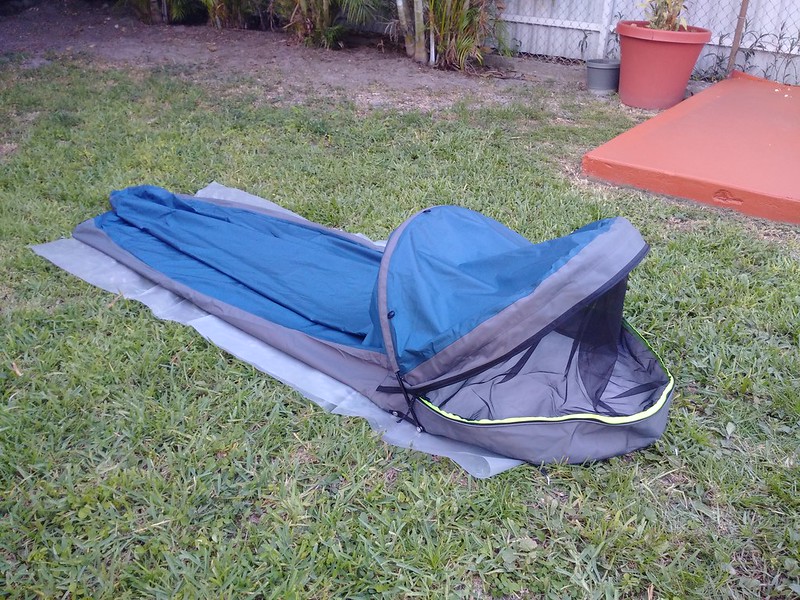 Outdoor Research Alpine Bivy by Dan Passaro, on Flickr Outdoor Research Alpine Bivy by Dan Passaro, on Flickr
Outdoor Research Alpine Bivy. Nice quality product, seems heavy duty. Hopefully not too hot at night. I spent about five minutes in it earlier. There is definitely some technique involved, both getting in and getting out. It is fairly easy to zip in when you are on your back. It's a bit easier zipping out when on your stomach. Turning over, moving around, etc revealed the wisdom in staking it down first lol. Packs up to about 15 inches long by 6 inches in diameter. A little bit of maneuvering with the bugnet in place will close the flap in case of rain. You cannot zip the hood with the bugnet in place so I'm considering adding some adhesive velcro right at the nose to hold it down. If it gets bad then I'll just have to unzip the upper portion of the bugnet and zip up the outside. The foot vent is gold. Awesome. I may get some long, thin coil to hold it up. You can stuff something into that area and trap it there. Perhaps some duct tape loops to guy it and hold it vertical. Naturally all that makes it into a half person tent  but that's part of the fun. but that's part of the fun. 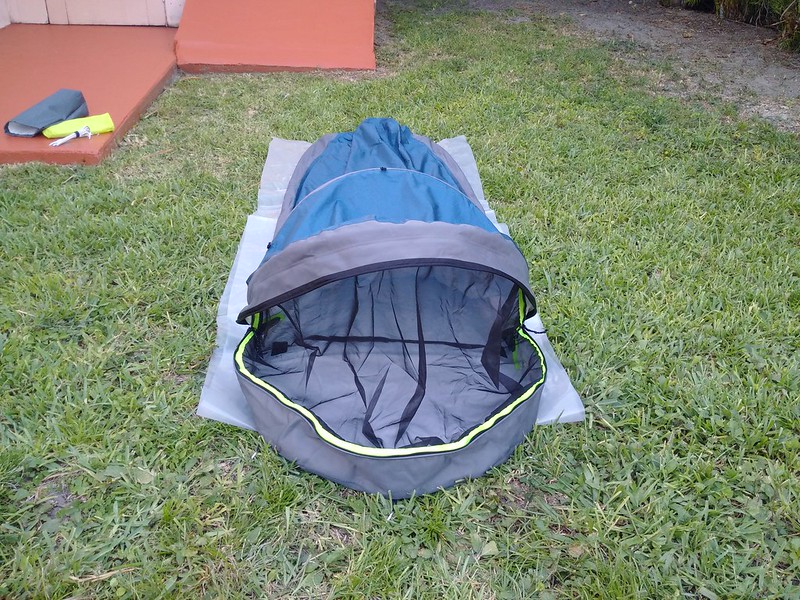 Outdoor Research Alpine Bivy by Dan Passaro, on Flickr Outdoor Research Alpine Bivy by Dan Passaro, on Flickr
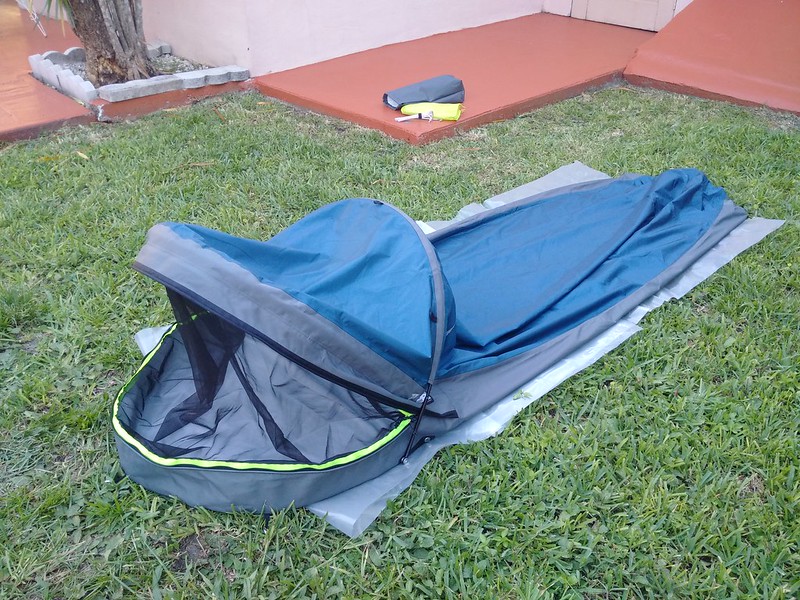 Outdoor Research Alpine Bivy by Dan Passaro, on Flickr Outdoor Research Alpine Bivy by Dan Passaro, on Flickr
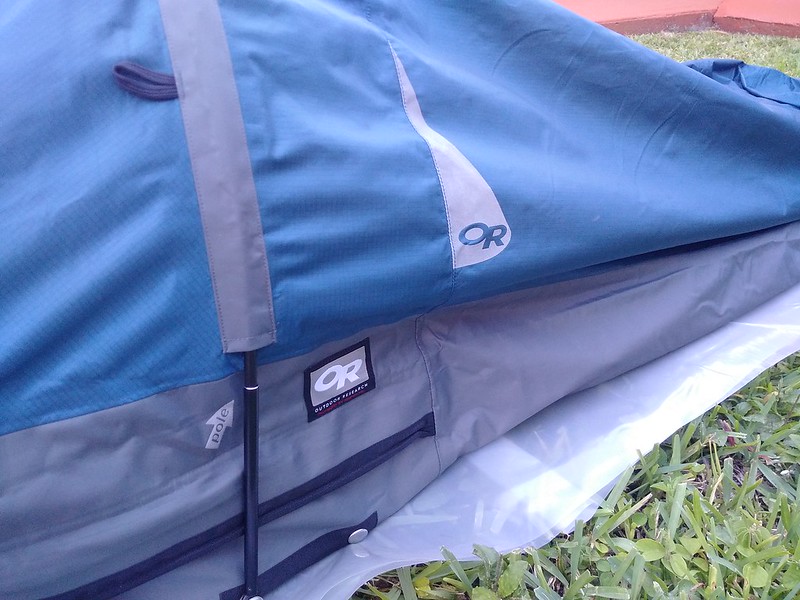 Outdoor Research Alpine Bivy by Dan Passaro, on Flickr Outdoor Research Alpine Bivy by Dan Passaro, on Flickr
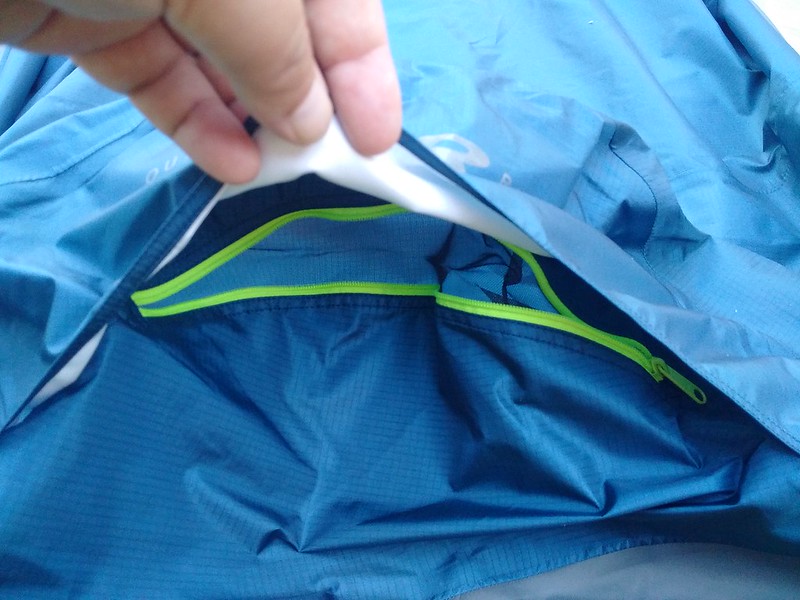 Outdoor Research Alpine Bivy by Dan Passaro, on Flickr Outdoor Research Alpine Bivy by Dan Passaro, on Flickr
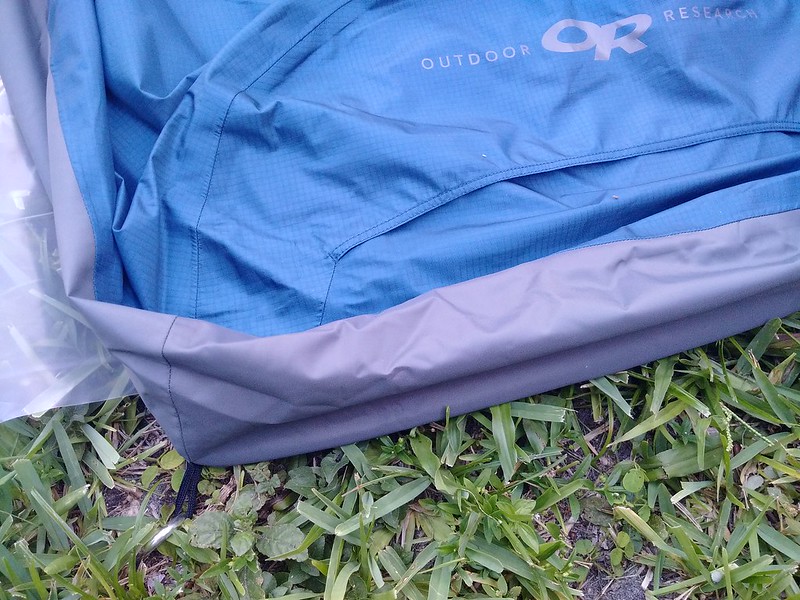 Outdoor Research Alpine Bivy by Dan Passaro, on Flickr Outdoor Research Alpine Bivy by Dan Passaro, on Flickr
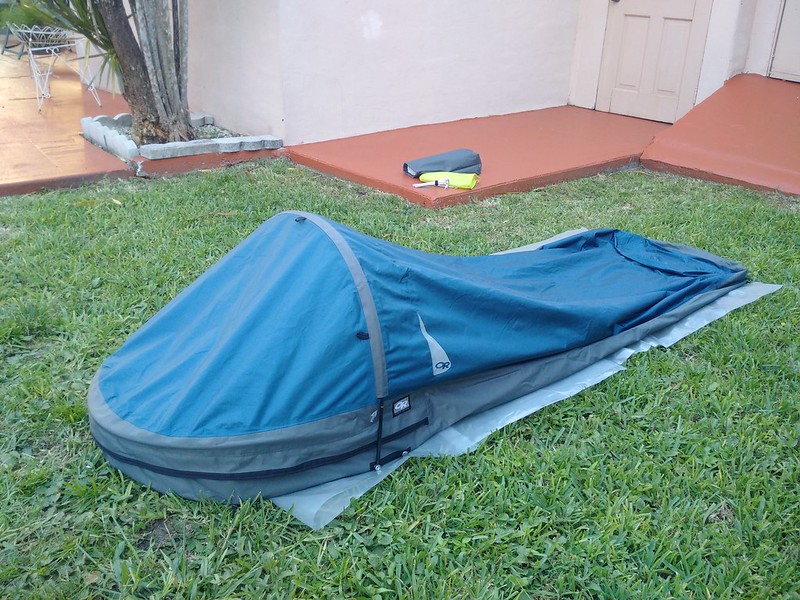 Outdoor Research Alpine Bivy - closed by Dan Passaro, on Flickr Outdoor Research Alpine Bivy - closed by Dan Passaro, on Flickr
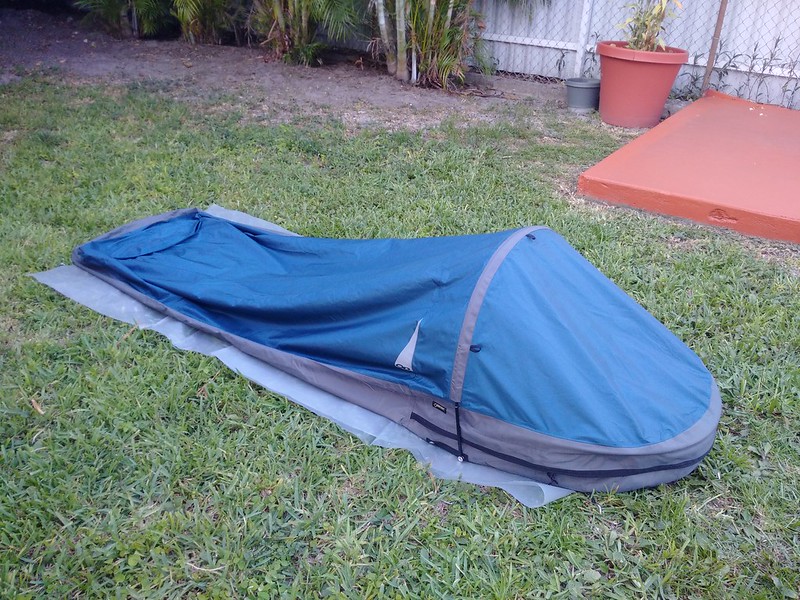 Outdoor Research Alpine Bivy - closed by Dan Passaro, on Flickr Outdoor Research Alpine Bivy - closed by Dan Passaro, on Flickr
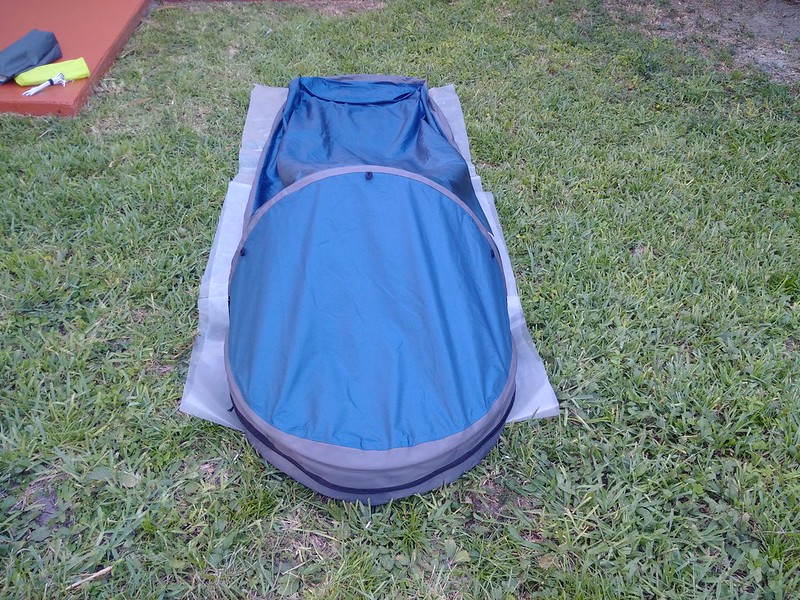 Outdoor Research Alpine Bivy - closed by Dan Passaro, on Flickr Outdoor Research Alpine Bivy - closed by Dan Passaro, on Flickr
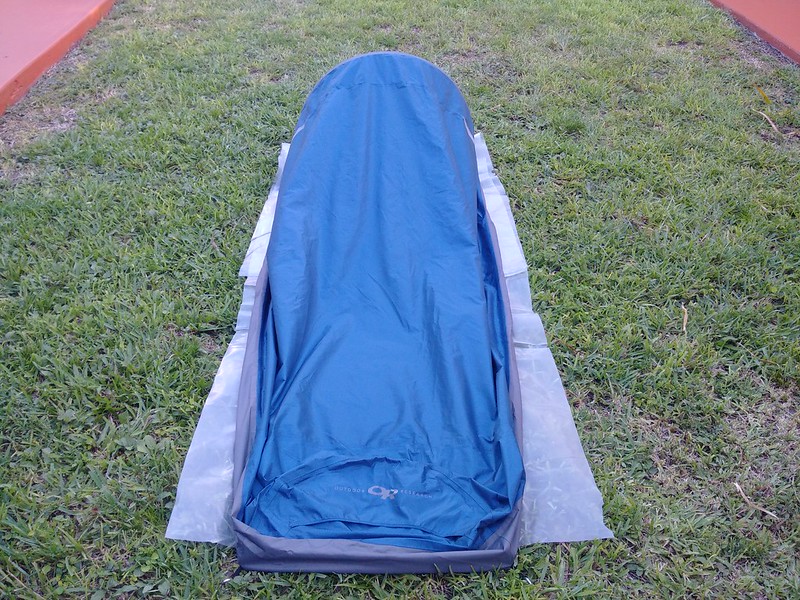 Outdoor Research Alpine Bivy - closed by Dan Passaro, on Flickr Outdoor Research Alpine Bivy - closed by Dan Passaro, on Flickr
|
|
|
|
I like the concept of a bivy, but can't justify it aside from stealth camping with some of the lightweight tent options.
|
|
|
|
It certainly fits better in the pack
As you can see the bivy is a on sheet of plastic ........... In the time it took to prepare the update and remind myself to get out there and stuff the ground cloth underneath, in case it rains, to prevent the rain from pooling up underneath ............. .......... it rained. And it pooled up 
I can report the floor is waterproof though Based on the rain I'll be guying the vent in some way. This way it won't end up laying flat, pool up water, and then leak in. |
|
|
|
For me a biv sack is a emergency device, not something to camp in on a planned basis. The Item that I camp in on a planned basis is called a tent. I have stayed in a biv sack twice, once in a hail/rain storm and once on a search mission.
|
|
|
|
Update 3:
I was cruising around Home Depot looking for the appropriate material and this is what I could find. 0.25in flexible PVC is what I found. I forget the brand name of the PVC (it's not flex PVC, with the spring thing inside) In this case I cut the pvc in half and used a 6mm screw as a center joint, so it would slide out easy. (6mm being less than 1/4in and I epoxied half the screw in one of the legs). I also notched the ends so they trap on the stake loop on each corner down there. This gets the footbox in the air to prevent water from pooling up in the area. I imagine that Outdoor Research didn't think much of a bivy being used in the heat of a south Florida summer, ie: very few materials inside to push up the footbox. It helps the bag feel roomier and of course also this helps promote air flow. 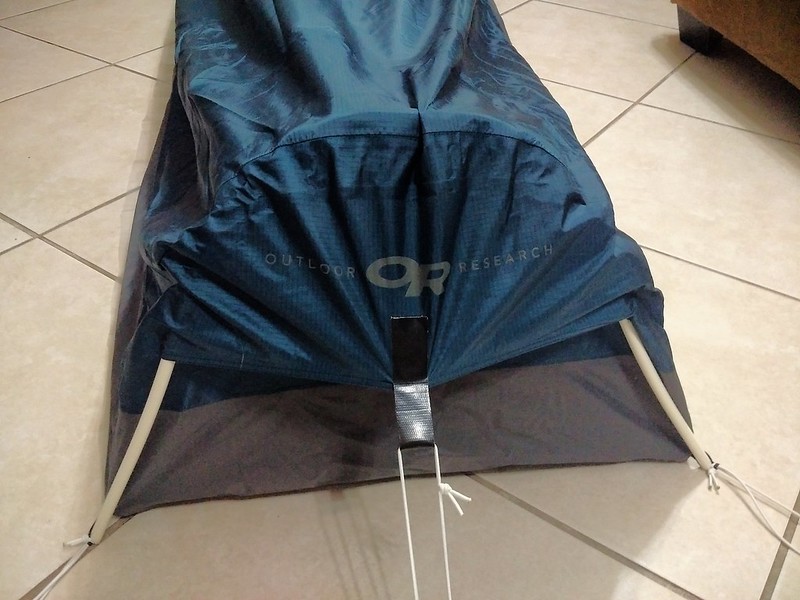 Outdoor Research Advanced Bivy upgrade by Dan Passaro, on Flickr Outdoor Research Advanced Bivy upgrade by Dan Passaro, on Flickr
|
|
|
|
I have one as a back up if I am planning on going leanto to leanto on backpacking trips. If the leanto is full I can bivvy up or if I am just doing an out and back solo where I don't want the Weight of a tent or hammock. I use mine for overnight hunting hikes as well. Hike in mid day find a good spot on some runs to set up and bivvy overnight to get early deer moving to feed deep in state land.
|
|
|
 Win a FREE Membership!
Win a FREE Membership!
Sign up for the ARFCOM weekly newsletter and be entered to win a free ARFCOM membership. One new winner* is announced every week!
You will receive an email every Friday morning featuring the latest chatter from the hottest topics, breaking news surrounding legislation, as well as exclusive deals only available to ARFCOM email subscribers.
AR15.COM is the world's largest firearm community and is a gathering place for firearm enthusiasts of all types.
From hunters and military members, to competition shooters and general firearm enthusiasts, we welcome anyone who values and respects the way of the firearm.
Subscribe to our monthly Newsletter to receive firearm news, product discounts from your favorite Industry Partners, and more.
Copyright © 1996-2024 AR15.COM LLC. All Rights Reserved.
Any use of this content without express written consent is prohibited.
AR15.Com reserves the right to overwrite or replace any affiliate, commercial, or monetizable links, posted by users, with our own.

